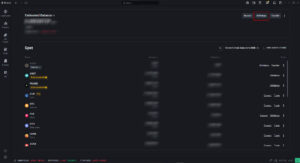Sending crypto to a casino is easy when you know what to look out for. This article will guide you through a safe journey from preparation to confirmation of your deposit.
How to send cryptocurrency to a casino safely
Will you choose the convenience of a verified exchange or full control in a self-custody wallet? We explain what this means for your responsibility and comfort, and how to make sure the payment arrives the first time. The right combination of currency and network, the exact address, an optional tag/memo, a small test amount, and a check in a block explorer. This helps you avoid mistakes that are mostly irreversible with crypto.
Popular payment methods
Two ways to make a safe deposit
Whether you’re sending crypto for the first time or just want to make a casino deposit quickly and without stress, you have two main routes. CEX/on-ramp (e.g., Binance, Kraken, Coinbase, Bitstamp, Coinmate) is the most convenient. It means easy controls, SEPA/payment card, and a direct withdrawal to the casino address. Self-custody gives you full control of funds, typically via MetaMask (EVM: Ethereum, BNB Chain, Polygon, etc.) or Phantom (Solana, but also Bitcoin and EVM). The first option means minimal hassle and quick support; the second requires working with a seed and greater responsibility, but the reward is freedom and flexibility. In both cases the same rules apply: always read the cashier for currency + network, copy the address, add a tag/memo where required, send a small test, and verify the transaction in a block explorer.
How to read the casino cashier
The cashier of most online casinos works very similarly. First, choose the currency (e.g., USDT, BTC, ETH) and the network (e.g., TRC20, BEP20, ERC20) from a preset list. Then confirm the amount, either one of the preset values or enter your own. After confirming, a recap window appears with key details: a QR code, the wallet address for the deposit, the selected currency + network, and possibly a destination tag/memo (for currencies like XRP/XLM).
The QR code is handy if you use a mobile wallet or an exchange app. Just scan it and everything is pre-filled. It’s not mandatory though—you can simply copy the address and paste it into your wallet/exchange manually (never type it by hand). Before sending, carefully verify that the currency and network match what’s shown in the cashier, check the first/last characters of the address, and for currencies requiring a tag/memo, really fill it in; without it the deposit may not be assigned.
If the casino allows it, start with a small test amount and only then send the rest. On some platforms the address has a limited time validity and there is a minimum deposit. Both are usually clearly stated in the window, so always check this information. After sending, you can track the payment via TXID in a block explorer and then wait for crediting after the required number of confirmations.
Best international online casinos
Sending from an exchange
Centralized exchanges (CEX) are the most convenient route. Everything is in one app, you quickly top up EUR (SEPA/card), buy crypto, and send it to the casino in a single withdrawal. The comfort has a price: centralization and no control over entrusted funds. If the exchange fails (e.g., a hack or incompetence), you don’t have the keys or direct control and you lose your funds (the fall of FTX is the most famous warning). Therefore, a simple rule applies: buy → send on. On the other hand, exchanges are practical for casino deposits because they offer many networks and good rates, have user support, and even a beginner can handle the transaction.
How to send crypto from Binance to a casino
- Open Wallet → Fiat and Spot → Withdraw.
- In the Coin field, choose the currency required by the casino cashier (e.g., USDT, ETH, BTC).
- Paste the address from the cashier into Address.
- In the Network field, select the same network you see in the cashier (e.g., TRC20, BEP20, ERC20, XRP Ledger, etc.).
- If the cashier shows a Tag/Memo (XRP/XLM, etc.), enter it in the appropriate field. Without it the deposit is usually not assigned.
- Enter the amount. For the first send, choose a small test (e.g., €10 within the casino’s minimum deposit limit).
- Check the summary: currency, network, address, tag/memo, fee. Confirm the withdrawal (2FA).
- Copy the TXID (transaction hash) and track progress in the block explorer of the given network.
- After the test is credited in the casino, repeat with the full amount.
- If you just bought the crypto by card, the exchange may place a short security lock on withdrawals (typically up to 24 h). In that case, wait, or use SEPA → spot → withdrawal.
- For future deposits, consider an Address Whitelist (allowed addresses), an anti-phishing code, and always use 2FA.
With this procedure, you minimize the risk of errors and delays. If the withdrawal „gets stuck“, first verify the TXID in the explorer (whether the block was confirmed). If the transaction is confirmed, wait for the number of confirmations required by the casino. If the funds still haven’t arrived, contact their support and attach the TXID + address + tag/memo.
Sending from a self-custody wallet
Self-custody means that you hold the keys, not the exchange. In the long run it’s safer and freer, especially combined with a hardware wallet like Trezor or Ledger, but it requires more discipline. That’s mainly in terms of seed backup, watching fees, and choosing the correct network. For casino deposits, it’s great if you want full control and to send directly from your own wallet. The downside? No one will „unlock“ your account if you lose the seed, and mistakes in the address/network are usually irreversible.
How to send crypto from the Phantom wallet
Phantom supports Solana (SOL + SPL tokens), Bitcoin, and is EVM compatible (Ethereum, Polygon, BNB Chain, etc.). The basic steps are very similar across networks. The key is to choose the right network according to the casino cashier and to have a small amount of the native currency for the fee (SOL/ETH/BNB…).
Before you start:
- Copy the address from the casino cashier, verify the currency + network and any tag/memo (Phantom does not send XRP/XLM where a tag/memo is mandatory—use a different wallet for those).
- At the top of Phantom, check/switch the network (e.g., Solana / Ethereum / Polygon / BNB / Bitcoin).
- Make sure you have a bit of the native currency for gas/fee (e.g., for USDT on Solana you need a few tenths of a cent in SOL; for USDT-ERC20 a little ETH, etc.).
A) Solana (SOL or USDT-SPL)
- In Phantom, switch the network to Solana.
- In the assets list, open SOL (or USDT) and tap Send.
- Paste the address from the cashier into Recipient (it starts with letters/numbers without „0x“; Solana addresses are base58).
- Enter the amount → Continue.
- Check the recap (token, amount, fee, address) → Send.
- Copy the TX signature and open it in Solscan/SolanaFM if needed. After the required number of confirmations, the deposit will be credited.
B) Ethereum / other EVM (ETH, USDT-ERC20, USDC-ERC20, BNB on BNB Chain…)
- Switch the network in Phantom to Ethereum (or Polygon/BNB Chain according to the cashier).
- Open the given token (e.g., USDT) → Send.
- Paste the address (EVM addresses are in the 0x… format).
- Enter the amount → choose priority/standard (if there’s a gas option) → Send.
- Verify the transaction via Etherscan/Polygonscan/BscScan per the network.
C) Bitcoin (BTC)
- Switch the network to Bitcoin.
- Open BTC → Send.
- Paste the BTC address from the cashier (sometimes bc1… / 3… / 1…; casinos usually use Bech32 bc1).
- Enter the amount → optionally choose the fee (faster/slower) → Send.
- Track progress in mempool.space or another BTC explorer; crediting may require 1–3 confirmations.
Important details
- Test transaction: for the first time, send a small amount, then send the rest.
- Correct network: USDT-TRC20 ≠ USDT-ERC20 ≠ USDT-SOL. Same token name, different network = incompatible addresses.
- Tag/Memo: if the cashier requires it (typically XRP/XLM), send from a wallet that supports that network including the tag/memo. Phantom does not support these networks.
- Token approval (EVM): for some EVM tokens, the wallet may require Approve before the first send (a small fee in the native currency).
- Seed & HW wallet: never photograph your seed; keep an offline backup. For larger amounts, connect Phantom to a Trezor/Ledger and sign outputs on the HW device.
Most common mistakes and how to avoid them
Currency ≠ network. The classic misstep is sending the right currency over the wrong network (e.g., USDT-ERC20 instead of USDT-TRC20). The address may look “right,” but it’s invalid for that network. The transaction won’t be credited and the remedy is difficult to impossible. Prevention: always read the casino cashier carefully first (currency + network), only then fill out the withdrawal in your wallet/exchange. For the first deposit, send a test amount.
Missing tag/memo for XRP/XLM. For currencies with shared addresses, a destination tag/memo is mandatory. Without it the payment lands on an „unidentified“ balance and you have to resolve this with the casino’s support—sometimes they help, sometimes not. Prevention: for currencies like XRP/XLM always fill in the tag/memo exactly as in the cashier.
Not enough gas. USDT/USDC/BTC/LTC, etc., are sent over specific networks and you always pay the fee in the network’s native currency (ETH/TRX/BNB/SOL…). If you don’t have it in your wallet, the transaction won’t go through. Prevention: before withdrawing, keep a small amount of ETH/TRX/BNB/SOL for the fee. When moving between wallets, first send a gas reserve.
Minimum deposit and address validity. Some casinos have a minimum amount and time-limited deposit addresses. Sending less or after expiry results in delays or loss. Prevention: in the cashier recap, check the min. deposit. If you’re unsure, generate a fresh address and stick to the limits.
Incorrectly copied address / QR outside the cashier. Manually typing leads to typos; scanning a QR code from an unknown page leads to scams. Prevention: always copy from the cashier and visually verify the pasted address (first/last 4–6 characters). Only scan QR codes from the casino interface.
Volatility of the wrong token. Do you need to send exactly €100? Buying and sending a volatile token (BTC/ETH) can end up ± a few percent due to price swings and a bonus condition won’t be met. Prevention: for fixed deposits, use a stablecoin (USDT/USDC) on a cheap network supported by the casino.
Low fee = a “hanging” transaction. On networks like Bitcoin/Ethereum, too low a fee causes the transaction to wait. The casino credits only after confirmation, which means you’ll wait longer than you want. Prevention: for BTC/Ether, don’t skimp on the fee when in a hurry. On EVM, choose standard/priority. On BTC, use “medium/high.”
Card purchase and withdrawal lock. Some exchanges temporarily limit withdrawals after a card purchase (typically up to 24 h) for security reasons. Prevention: if you’re in a hurry, use SEPA → spot → withdrawal, or expect a delay with a payment card.
Bridging at the last minute. Bridging a token across networks right before a deposit increases the risk of errors (wrong wrapped token, time delay). Prevention: buy directly on the correct network the casino accepts. Bridge only if you know exactly what you’re doing—not right before a deposit.
AML/KYC delays. Significant increases in amounts, frequent deposits/withdrawals, or unclear source of funds can trigger additional checks at the exchange and in the casino. Prevention: send from an account in your name, have documents handy (ID, Proof of Address, possibly Proof of Funds), and keep transactions clear and consistent. If a check occurs, communicate factually and provide the requested documents.
Phishing and fake support. If “support” asks for your seed/private keys or offers to speed up a deposit, it’s a scam. Prevention: never share your seed, contact support only via official chats/emails (ideally from bookmarks), enable an anti-phishing code on the exchange, and use an address whitelist.
Sending from/to incompatible wallets. Some wallets don’t support certain networks or address types (e.g., EVM vs. Solana, BTC formats). Prevention: verify that the sending wallet supports the given network and that the casino accepts it.
How to recover when things go wrong
First, find the facts. Look up the TXID in the relevant explorer, verify the network, address, tag/memo, and number of confirmations. If the transaction is confirmed on-chain, wait to see if the casino requires more confirmations. Still nothing? Contact the casino’s support and attach the TXID, exact address, tag/memo, amount, and time. If you sent via a different network, the chance of recovery is small. Try to resolve this mistake with the casino support.
The point of the whole article is simple: most errors are preventable and in the vast majority of cases these errors happen on the user’s side. Read the casino cashier carefully, double-check the currency + network + address (+ tag/memo), send a small test first, and only then the full amount. This process is the best insurance against unnecessary loss.












Discussion, comments and your experiences
Share your opinion, ask a question, or offer advice to others in the moderated discussion. Editors also participate, but they respond based on their current availability. If you expect a direct response, we recommend using email communication instead.